Cronobiografía
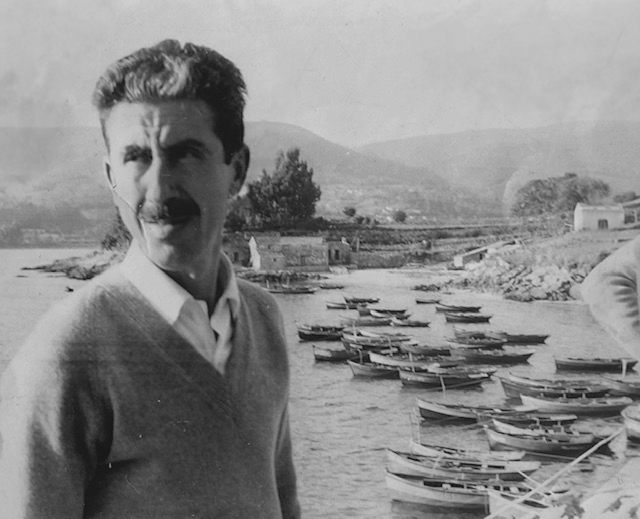
Xosé Conde Corbal, 1971
1923
Born in Pontevedra, en April, on the street dedicated to his grandfather Benito Corbal. Son of José Conde Pérez and Trinidad Corbal Souto.
1928
He studies at the private school of doña Estrellita, in the street Michelena.
1929
He studies in Balmes, in the Plaza de Méndez Núñez.
He espends summers at the Pazo de Ramirás, Untes, near Ourense, from where his father came from.
1930
He starts drawing with his uncle Sixto Vizcaíno.
1932
He frequents the studio of Bibiano Fernández-Osorio and Tafall, where he learns the art of scientific drawing.
1934
He studies at Instituto de Pontevedra.
1940
He begins law studied at the University of Santiago. He starts dating Margarita Escuredo Lago.
He forms a group of artists with his friends Rafael Alonso, painter and Juan Manuel Castuera, photographer.
1941
He starts his studies in Chemistry in Santiago.
1942
He drops out of University. He passed his teaching courses.
1945
He moves to Benavente, where he runs a ceramica factory in partnership with his brother -in law- Javier Vázquez.
1947
He marries Margarita Escuredo Lago, daughter of the preserved food businessman Eugenio Escuredo Lastra.
He spends summer in O Grove, the home of his in-laws.
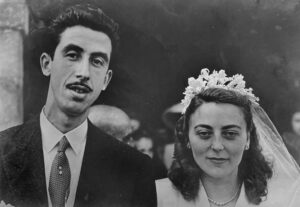
On his wedding to Margarita Escuredo.
Photo: Juan Manuel Castuera.
1948
His first daughter, Margarita is born.
1949
His son José Manuel is born.
1950
He starts to collaborate with the press, the newspaper El Imperio, from Zamora. He writes text about historicism.
His son Enrique, is born in Benavente.
1951
He returns to Galicia. He works in the factory of chemical fertilizers La Cross, in Pontevedra. He continues collaborating with El Imperio. He draws marine environment works with the technique of gouache.
1952
Collaborations with El Imperio. He draws landscapes during the summer.
1954
Runs a tungsten mine in Lobios. He lives in Ourense and works as administrative officer of the tungsten mine.
He starts collaborating with the newspaper La Región, Ourense. They would be drawings, he would not write texts, only occasionally. He moves with his family to Ourense.
1955
His daughter María Dolores is born.
1956
He works in the windows workshop La Belga, making leaded lights.
His son Eugenio is born.
1957
He prepares in Meloxo, O Grove, his first exhibition.
1958
Exhibition at the Liceo Recreo of Ourense. Guaches and some marine-themed landscapes.
In March he exhibits at Sala Velázquez ,Vigo; in August al Assembly Hall of the local Council of Pontevedra and in September at the tourist office of Santiago. The themes are seascapes, landscapes, flowerss and still lifes, the technique is guache.
His son Agustín is born.
His son Eugenio dies.

In one of his first exhibitions
Photo: Antonio Gabriel
1959
He frequents the company of a group of new artists, called by Risco “Os artistiñas” formed by Xosé Luís de Dios, Acisclo Manzano, Xaime Quessada, Virxilio…
1960
Exhibition in February, at the Liceo Recreo Orensano: lanscapes, portraits and seascapes. In March, exhibits in Sala de Arte Juvenil, en Ourense; divides the exhibition into five themes: sea, people land, man and cows. In July exhibits in Sala de Arte La Troya, de Ourense, gouaches with seascapes and landscapes. He starts his collaboration with La Región, with the title “Ourense perdurable”; drawings featuring texts of Vicente Risco. He makes illustrations for La Hoja del Lunes in Ourense called “Pueblos y ciudades de Galicia” with texts by Vicente Risco, Ferro Couselo, Xaquín Lourenzo, Otero Pedrayo…He makes posters, magazine covers and murals under commercial order, such as the one of comercio Mileva, now disappeared.
His son Gonzalo is born.
1961
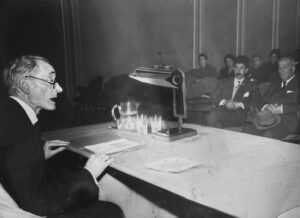
Vicente Risco giving a lecture, among the audience Conde Corbal
Photo: Reza
He exhibits watercolors in the series “Enduring Ourense” at the Claustro del Museo Arqueológico Provincial of Ourense. What was drawing in black, in now colourful watercolours: streets, squares, houses, churches. He colaborates with the magazine Cuadernos de Galicia. Publication of the book The enduring Ourense, with 42 drawings by Conde Corbal, commented by Risco, foreword by Otero Pedrayo and notes by Ferro Couselo. Makes the poster for the Ourense Festival.
Birth of his daugther María Eugenia.
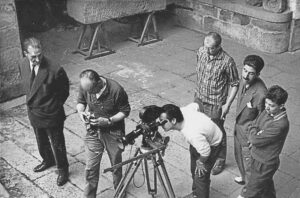
Filming of a movie by José Val del Omar with Xaquín Lorenzo, Virxilio,
Arturo Baltar and Conde Corbal. Photo: Anric Massó.
1962
Exhibition in January in the Sociedad de Amigos del Arte, at the Biblioteca Nacional de Madrid, in a group exhibition of artist from Ourense, with Quessada, De Dios, Virxilio, Arturo Baltar, Acisclo Manzano…In September he exhibits drawings, guaches and watercolors, related to the city at the Instituto de Pontevedra and in the Pazo de la Diputación he exhibit works that complete the series. In December he exhibits oil paintings, guaches and drawings in the Sala de la Caja de Ahorros Municipal, Vigo. He edits the map Ourense Provincia Monumental.
His son Ángel is born.
1963
Xaime Quessada founded the group Volter, name suggested by Risco in memory of the Café Voltaire de Zurich, where dadaístas used to meet. They met at Tucho Tavern, later known as O Volter, and they painted on their walls, and they sat around talking to the members of generation Nós: Risco, Otero Pedrayo, Ferro Couselo, Xaquín Lourenzo.
Vicente Risco died.
He publishes drawing in the newspaper Faro de Vigo, with texts by Gerardo González Martín, of the series “Viaxes por Galicia” and “A ruta do Miño”. He starts working with the newspaper Diario de Pontevedra.
The County Council of Pontevedra buys about 60 dibujos, and plant to edit “Pontevedra perdurable”. He paints murals under the name Pontevedra, for the council, and Beato Sebastián Aparicio, for the Franciscan Convent of Ourense.
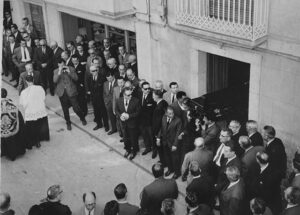
Carrying with Xaquín Lorenzo the coffin of Vicente Risco.
1964
He publishes “Del Orense Monumental”, with texts by Ferro Couselo; and the map “Ourense Pórtico de Galicia”. Diario de Pontevedra publishes the series “A fe nas pedras” around the popular belief in miracles, with texts by Ferro Couselo, Luis Cochón, Alfredo García Alén and Puga de Alongos one of his heteronyms. Faro de Vigo publishes “Los caminos de Santiago” series with texts by Celso Emilio Ferreiro.
Birth of his daughter, María del Carmen.
1965
He exhibits gouaches, drawings and watercolours, with seafaring, ethnographic and landscape themes at Pontevedra. He continues in Diario de Pontevedra with the series dedicated to the Holy Year . He also dedicates contributions to the seafood Fesival in O Grove. He publishes “Os santos galegos”, in Faro de Vigo.
He publishes Pontevedra en 50 dibujos, with a foreword byFilgueira Valverde and notes by Alfredo García Alén, and the brochure Santiago llegó por mar. He edits the map Baixa Limia. He makes a mural for the Café Carabela of Pontevedra.
He starts collaborating with the magazine Vieiros.
1966
He exhibits at the Caja de Ahorros Municipal de Vigo watercolours under the title “Xentes do mar”. He moves the exhibition to A Estrada and Ateneo de Pontevedra. Diario de Pontevedra publishes the series “Museo de Etnografía e Historia de Porto”, “Y el Miño nos une a Portugal” and “Flores, gastronomía y folklore en Porto”. He edits “Cruceros, petos y santos”; Pontevedra: la tierra y sus gentes; and “Centenario de Valle Inclán”. Speaker at the International Congress of Ethnography of Póvoa de Varzim, where he presents the series“Etnografía na obra de Valle Inclán”. He collaborates with the staging of “Luces de Bohemia”, in Ourense.
Birth of his daughter Ana María.
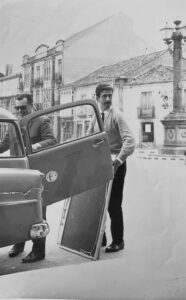
Setting up an exhibition in A Estrada with Xosé Matalobos.
Photo: Antonio Gabriel
1967
He edits the work “Pontevedra: La Tierra y sus gentes”. And posts the poster dedicated to Miguel Hernández.
1968
In January he exhibits in Marín, including watercolors about usual topics: dornas, fishmongers, sea… in March exhibits in Ourense; in May inVigo; in June in A Coruña and Santiago; and in July in Lugo in the Yuma tavern, they are the work of endearing men and women from Galicia. Collaborates with Santiago’s newspapers La Noche / El Correo Gallego and the magazine Nova Galicia, México. He carries out with Chamoso Lamas the exhibition of the Galician Romanesque in Santiago de Compostela.

1969
He moves to Madrid. Exhibition of drawings and gouaches in Sala Toisón, Madrid. He draws the mural Bancos desde La Cibeles, for Banca di Lavoro. He starts collaborating with the magazines Chan, and Nivel. Illustration for El Divino Sainete by Curros.
1970
He exhibits paintings and drawings in two galleries of Ourense. He post the poster “Histrión 70”. continues his collaborations with Chan.
1971
In May, he exhibits drawings in Vigo and in August, in Monforte, in the group exhibition ”Pintura al óleo, acrílicos, ceras, dibujos de Artistas Galegos”; in October he exhibits drawings and paintings, in Vigo; in November and December, he exhibit engraving with Elvira Blanco, in Ourense, Santiago, Pontevedra and Vigo, expone los grabados. Illustrated with Isaac Díaz Pardo, “O cabaliño de buxo” by Xosé Neira Vilas.
1972
In June he exhibits “Obra gráfica.Valle Inclán”, in Ourense. In October he also exhibits the work related to Valle Inclán in A Estrada. He starts editing his engravings in offset and selling them at the exhibitions. Meets Carol S. Maier, American proffesor, specializing in Valle Inclán, who buys 24 prints of this series. Publication of the book “Pazos de Pontevedra”. He paints the mural Tying nets for Caja de Ahorros de Pontevedra in Vilagarcía de Arousa.
1973
In April, Carol S. Maier exhibits in Rutgers, the State University of New Jersey, the engravings she had purchased. In May she exhibits the works related to Valle Inclán in Ourense, and in September they are returned to the U.S. to be exhibit at Bradley Center. Conde Corbal edits the series of engravings: “Vigo”, “Xentes do mar de Vigo”, “Desnudos”. He also edit the book “A dorna e os que viven dela”. He returns from Madrid and settles in Vigo.

Carol Maier in a conference with Antonio Odriozola and Filgueira Valverde among others.
1974
He exhibits the engravings related to Valle Inclán’s work at Ribadavia during the Theatre Festival, whose poster and catalogue were made by Conde. He exhibits the engravings handed over by Carol S. Maier in New York. In Ourense he shows Castelao’s drawing and makes the catalogue and poster of the activity “Sempre na Galiza. Homenaxe a Castelao”. Paints a mural of chapel Virxe das Mareas, in O Grove.
1975
He exhibits engravings in Ourense, related to seafoof and the city. He prints the engravings series: “Retratos”, “Ribadavia” and “Nenos, mulleres e vellos”. He paints the mural “A Alba da Gloria de Castelao”. Returns with his family to live in Ourense.
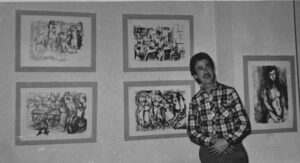
In an exhibition of engravings
1976
In March he exhibits in Ourense, seascapes’ acrylics made on chipboard plank; in December, the series about birds, previously published in La Región. Portrait of Otero Pedrayo. Poster of Nós. He edits the engravings of the series Na procura de fauna galega and Nós. He illustrates “Oración fúnebre” [by Otero Pedrayo] of priest Isorna.
1977
He exhibits some portraits of writers from Ourense and acrylics in Ourense. He collaborates in a citizens’ campaign [Adepende group], to save Teatro Príncipal. He edits “Ourense perdurable”, and “A dorna e os que viven dela”. He designs posters for differente things: “Canteiros de Cerdedo”, “Romaría de San Xurxo de Sacos”, “Basilio Álvarez”, “Tomás Camacho”…
1978
He exhibits in Ourense the series “A dorna e os que viven de ela”. Makes a series of 31 engravings, “A Ribeira Sacra”. Continues publishing the series “Fauna Galega e Paxaros” in La Región. He designs posters for the Festival de los Remedios do Castro Caldelas, with Irrio Peliqueiro as the motif of this poster and the motif of the exhibition “O Monte en Galicia”. He prints the series “Fauna Galega: especies de río; and Mamíferos”. The book “Escolma de cantigas” is printed with his drawings. Carol S. Maier publishes her article “Seis gravados de Xosé Conde Corbal. Notas para unha exposición valleinclanesca” in the magazine American Hispanist. He paints a mural in IES Vilalonga, in Sanxenxo.
1979
Exhibition of portraits of the group Nós at the Instituto da Xunqueira in Pontevedra.
1980
He prepares the edition of “The Fardel of War”and edits the map Galicia e Minho deica o Douro. The magazine Grial publishes the article by Carol S. Maier “Xosé Conde Corbal e a estética do gravado. Unha reforma do ollo por medio da deformación da liña”. He lives in Pontevedra
1981
Exhibition at the Instituto da Xunqueira, in Pontevedra, of seascapes and marine sealife series. He participates in Colectiva de Pintores de Pontevedra Capital, in Pontevedra. He exhibits featuring his son Enrique in Pontevedra: “Conde Corbal. Enrique Conde”.
Travelling exhibition about seascapes of Galicia. He illustrates articles about Torrente Ballester for the newspaper La Voz de Galicia. Reprint of Ourense perdurable.
1982
Exhibition “Vicente Risco e o seu tempo”, at the Museo de Pontevedra. Sporadic collaborations with La Región and La Voz de Galicia. Poster Pontevedra monumental. Series of engravings: “Especies mariñas”; “viaxe a Italia”; “Camelias”.
The book Patología de la camelia en Galicia, is printed with his illustrations. He settles with his family in O Grove, where his wife, Margarita, manages the family canning company.
1983
He exhibits seascapes, flora and landscape painting. At the Museo de Pontevedra exhibits engravings based on Valle-Inclán’s work. Collaborates with La Región and Faro de Vigo. Makes the map “Fauna e Monumentos” [of Pontevedra].
1984
Exhibition in Vigo: Vicente Risco na súa obra. He edits the series of engravings about Risco, y Peces y flores de Galicia. He illustrates the books: O Grove, Pontevedra, and Polos vieiros do mar.
1985
Exhibition Ourense en Pontevedra, in the Museo de Pontevedra, paintings, prints and drawings related to Ourense. Works with La Región, Faro de Vigo, Disque and the magazine Corredoira. Makes the mural Persoeiros da Ría de Arousa, for Fexdega [ organizer of the fairs and exhibitons of Vilagarcia]; maps “Fauna das Rías Baixas” and “Historia das Rías Baixas”, and the poster, folder and program of the II week of Philosophy, in Pontevedra. He moves to Vilagarcia de Arousa.
1986
Participates in the group exhibition Valle Inclán y su tiempo hoy, with engravings of the series of Valle. Exhibits engravings related to Valle-Inclán at the Museo de Pontevedra. “Recopilación de trabajos sobre la camelia” is published with his illustrations.
1987
He exhibits engravings of the series “The Fardel of war”, at the Museo de Pontevedra and the Museo do Pobo Galego, in Santiago. He edits a folder with 88 engravings of a “O Fardel da Guerra”, numbered and assigned by the author. The folder Nuestras árboles, is edited featuring ten of his drawings. Collaborates with La Voz de Galicia.
His Serie erótica, that Conde planned to exhibit in an art gallery of Vigo, is rejected. He illustrates the cover of the magazine of the Cultural Association of A Seca, with an allegorical motif: Maios
1988
He participates in the group exhibition Vanguardias y Silencios, in Teatro García Barbón, in Vigo, ; with two acrylics; and in Camelia 88, Vilagarcía, in which he shows a portrait of Antonio Odriozola. Serie erótica is presented in the bar CopaT, of Vilagarcia, series that later will be edited. Laude da Camelia, is published with his illustrations. Collaborates with La Región, La Voz de Galicia and the magazine Atlántico. He illustrates the Catálogue of the Prize Antón Losada Diéguez. He paints a mural dedicated to the musician Manuel Quiroga in the UNED, Pontevedra.
1989
He exhibits “Gravados sobre a obra de Ramón María del Valle Inclán”, in Vilanova de Arousa. Exhibition Conde Corbal. Antolóxica, at the Museo Provincial de Ourense. Publication of “Catálogo Conde Corbal”, with texts by X. Antón Castro, Carol S. Maier and María José Tiscar. The same “Antolóxica” is exhibited again at Museo de Pontevedra. He paints the mural “Intelectuais da Ría de Arousa”. Collaborates with the magazine Liceo Marítimo of Vilagarcia.

At the inauguration of the mural “Intellectuals of the Ría de Arousa.
1990
Exhibition Conde Corbal. Antolóxica, at Fundación Caixa Galicia, A Coruña; Museo do Pobo Galego, Santiago; and Círculo das Artes, Lugo. Exhibits Fauna marina, watercolours and engravings, in Vilagarcía de Arousa. He collaborates with illustrations in the edition of the Galician version of Don Quixote. His mural Alba da Gloria is assigned to the Faculty of Economics, Santiago. The magazine Do mar, is published with his illustrations.
His son Agustín dies.

At the opening of his anthological exhibition, on the right Alfredo Conde.
Photo: Mani Moretón
1991
Publication of the Catalogue of the Art Collection of the Faculty of Economics, Santiago. He publishes a series of illustrations about the camelia: Laude da Camelia e outras cosas.
1992
He exhibits acrylics in Fexdega, Vilagarcia de Arousa, titled Círculos. He collaborates with La Voz de Galicia.
1993
He exhibits acrylics and engravings at the Museo Provincial de Ourense, entitled Memoria dun Pobo. This exhibition will travel to Fisterra, Vilagarcia and Pontevedra. Exhibit Publication of the book Y luego Lugo ¿qué?… with his engravings. Paints the mural Comarca de Arousa.
1994
He participates in two group exhibitions: “Coincidencias”[in Vilagarcia and Cambados, whith two acrylics of dornas] and O gaiteiro nas Artes, in Allariz. He paints the mural Persoeiros de Ourense. Publication of the book “Poetas urbanos”, with an illustration on its cover.
1995
He participates in the group exhibition entitled O gaiteiro nas Artes, in Cambados and other places like: Narón, Melide, A Pobra, Ribeira…
1996
He works in several previous series of prints, with the intention of making new editions.
1997
Tribute to Antonio Odriozola in Vilagarcía. Portrait by Conde Corbal in the cover of the catalogue. He draws series of camelias.
1998
The book Vista pictórica. Parque del Castillo de Soutomaior, is published with illustrations by Conde Corbal. He works on the artworks of the series Pueblos y ciudades de Galicia, with the idea of being published in the future.
1999
Xosé Conde Corbal dies in March, at his house in Vilagarcía de Arousa.